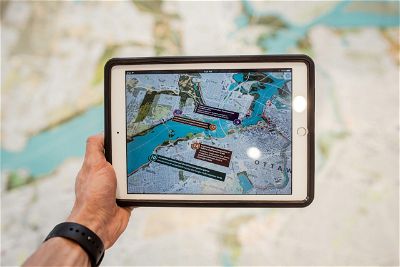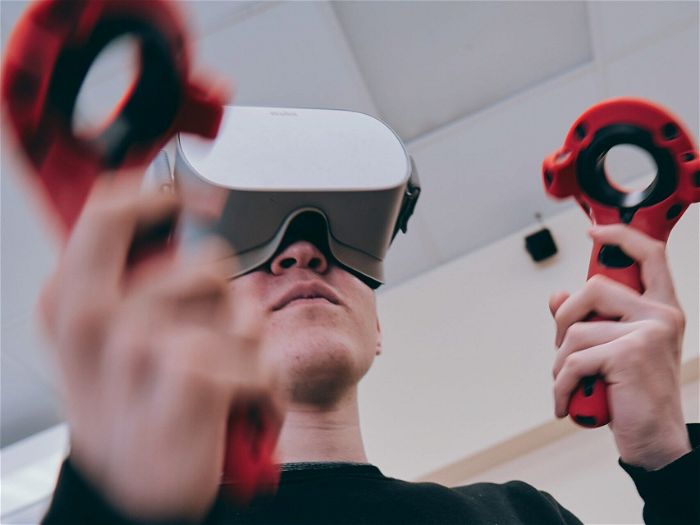
Launching Augmented Reality Training in Community Colleges: Your Guide to Getting Started
April 16, 2024
At a Glance
Dive into the transformative world of augmented reality (AR) programming, an emerging training shaping the future of education.
In a rapidly evolving skill-development landscape, community colleges must stay ahead of technological advancements to serve as innovative economic engines in their regions. To help their communities develop in-demand skills for the quality jobs of the future, community colleges need to embrace groundbreaking augmented reality (AR) training. Foundational AR training equips learners with the skills to create their own AR experiences, teaching them how to build, service, and incorporate AR tools across a wide variety of applications. However, because AR training opportunities are still emerging, many community college leaders might be unsure of where to begin, especially when looking to serve a diverse group of learners, some of whom might be facing systemic barriers in education and the job market.
Jobs for the Future’s (JFF) recent AR pilot partnership with eight community colleges across diverse regions in the United States has revealed a variety of approaches for where to begin AR programming at the college level. We saw four main approaches:
A. Programming exclusively for noncredit learners
B. Wider recruitment through a noncredit offering open to all learners
C. Programming embedded within an existing academic track
D. Collaborative programming by a group of colleges
Each approach has certain advantages for recruitment, implementation, and program sustainability. These snapshots of diverse training strategies taken by our partner colleges should inform and inspire community college leaders seeking insights relevant to the distinct needs of their institution and learners. It is also worth noting that all partners established programming fairly quickly—over just one semester—so these initiatives should be viewed as starting points for further learning and refinement.
For more detailed information on launching augmented reality programming, read our how-to playbook.

A. Programming Exclusively for Noncredit Learners (Mott Community College—Flint, MI)
REASONS TO CONSIDER:
- If a community college seeks to prioritize local community outreach and engage new learners, AR training can serve as a valuable draw. This approach brings in learners who may or may not have prior connection to the college with AR programming acting as a gateway to other relevant programming, such as 3D modeling, coding, or marketing, while generally exciting learners about the college and its offerings.
- A community college can prioritize inclusivity by focusing recruiting efforts on noncredit learners without application restrictions based on prerequisites. This approach, employed by Mott Community College, demonstrates a commitment to democratizing AR, ensuring that programming remains open to learners who typically do not have access to new tech training.
I’m currently working at a factory, and I was looking to go back to school. This program definitely helped me to get back into the learning process.
Aquarius Chaney, learner, Mott Community College
Recruitment:
- While every approach included context for what AR is and how it is applied in early information sessions, the champions for programming targeted at noncredit learners must provide especially clear and engaging representations of AR’s utility to various career paths, because students will be approaching AR with diverse interests and existing skills.
- Given the broad scope of recruitment, two months of active engagement are crucial to ensure a robust cohort of learners.
- Because recruitment extends to learners not previously connected to the college, program champions must devote additional time and attention to facilitate registration. For example, Mott held open sign-up sessions with registration facilitators immediately following every information session.
Implementation:
- This approach may require additional “basic tech” curriculum, because many learners will not have foundational technical knowledge.
- Mott’s instructional staff incorporated basic lessons on coding, tech terminology, project management, and entrepreneurship to make the AR content more accessible and to provide further skill development relevant to quality jobs.
- Because the instructional demands of this approach will require the complete focus of the program instructor, it is important to have a program champion (if possible, from the workforce development side of the college) overseeing all administrative aspects of the training, from budget to logistics.
- Wraparound supports, such as child care, transportation, and food pantry access, are essential to assist the participation of noncredit learners.
Considerations:
- Leaders contemplating this approach should assess their college’s history of recruiting noncredit learners. For example, Mott’s initiative required strong relationships with community-based organizations to enhance recruitment efforts.
- Consider offering optional companion noncredit coursework, either before or after programming concludes, to connect learners with other relevant offerings at the college.
These minds that are interested in the course are coming from many different types of perspectives, backgrounds, experiences, and understandings. The open entry model is what will truly allow [these] students to get to know how to use this tool and perhaps even allow them to apply what they are learning to what they do on a daily basis. For example, a person working at a photography studio can offer their employer augmented reality frames to use with their photos; a person who is studying IT can tap into their creative side and learn more about creating assets for programs.
Kyle Williams, instructor, Mott Community College

B. Wider Recruitment Through a Noncredit Offering Open to All Learners (Southeast Kentucky Community and Technical College—Cumberland, KY; Isothermal Community College—Spindale, NC)
Reasons to Consider:
- To democratize AR training, colleges can implement a wide-scale approach by embedding programming as a noncredit offering, but casting a wide net for recruitment that includes noncredit learners, full-time students, and local employers and workers looking to upskill. Southeast Kentucky Community and Technical College (SKCTC) and Isothermal Community College both took this approach.
- Diverse interests and professional backgrounds will mix within cohorts of learners, demonstrating a wide variety of AR uses from health care to music education and beyond.
Recruitment:
- Program champions must have influence across several key areas, including faculty in relevant departments for full-time learner recruitment, workforce development and noncredit leadership within the college, and local employer networks to communicate the opportunity to full-time workers looking to upskill.
- SKCTC emphasized the recruitment of full-time workers and local employers, as well as collaborating with a workforce development contact within the local chamber of commerce to pitch programming at relevant events such as “Shaping Our Appalachian Region” (SOAR).
Implementation:
- Similar to programming offered exclusively to noncredit learners, this approach requires curricula that can accommodate learners without basic tech knowledge. In addition, due to the diversity of learner interests, program champions and instructors will need to provide context for AR’s applicability to a wide range of fields throughout programming.
- Because this approach incorporates full-time workers, its implementation must be flexible and responsive to worker needs, including classes scheduled later in the evening and on weekends, child care offerings, and multiple weekly options for office hours.
Considerations:
- This approach can attract more students with bachelor’s degrees seeking a direct connection to their current jobs. Program champions must have broad contextual knowledge of AR’s wide applicability to different careers to communicate the technology’s utility to the local workforce.
- In a closing student project showcase, SKCTC invited the CEO of a local hospital, business services representatives, a local physical therapy provider, and other businesses, to bring employer voices into the programming and create a dialogue with students about the need for AR skills.
Augmented reality training provided a new opportunity for our communities to gain innovative skills for the workforce of tomorrow.
Sandra Brown, apprenticeship coordinator, Southeast Kentucky Community and Technical College

C. Programming Embedded Within an Existing Academic Track (Kingsborough Community College—Brooklyn, NY)
Reasons to Consider:
- Launching AR programming exclusively with current learners and alumni within an established academic track is a strategic use of a school’s existing instructional knowledge and recruitment practices.
- This approach can help learners to contextualize AR skill development within their existing career interests.
- Kingsborough Community College (KCC), acknowledging their strong user experience (UX) programming and the utility of AR for UX design career paths, developed programming through a UX lens.
Recruitment:
- The recruitment lift is significantly easier than opening the program wide, because a community college can rely on its existing recruitment channels for a given field.
- For KCC, recruitment sessions and materials emphasized AR’s direct application to UX design scenarios.
- Consider, as KCC’s program champions did, using a brief application process to gauge learner commitment and determine student interest in incorporating AR into their specific skill set.
- For UX design students, an AR program that provides them with unique projects to bolster their portfolios serves as a strong incentive.
Implementation:
- Consider recruiting an instructor with overlapping expertise. At KCC, an instructor with expertise in both UX design and AR repackaged an existing AR curriculum (Meta Spark) specifically for the needs of UX design learners.
- Because UX learners may not have a technology or software engineering background, foundational tech tutorials within the curricula are essential. However, UX learners’ ability to brainstorm ideas for AR products is a significant advantage for the group.
- Choosing a specific theme for the capstone event can encourage final projects that are particularly relevant to the learners in a given track. KCC learners’ final AR projects centered on a “tech for good” ethos, which motivated learners to blend their UX design and burgeoning AR skills into productive and inventive ways to support their community.
Considerations:
- This approach can be employed for graphic design, marketing, computer graphics, 3-D modeling, computer science, web development, and coding, among other areas particularly relevant to AR training. For example, Cañada College (Redwood City, CA) developed programming for digital art and animation learners.
- In future iterations, program champions can choose to either relaunch programming as a noncredit offering or embed it within for-credit coursework.
UX designers are now playing integral roles in shaping digital experiences beyond the web and mobile apps. UX designers can now shape future tech experiences like augmented reality…[L]earning AR today will help UX designers stay ahead of tomorrow.
Michael A., instructor, Kingsborough Community College

D. Collaborative Programming by a Group of Colleges (Red Rocks Community College—Lakewood, CO; Pikes Peak State College—Colorado Springs, CO; and Community College of Aurora—Aurora, CO)
Reasons to Consider:
- For community colleges that don’t yet have the institutional capacity to launch AR programming on their own, a collaboration between colleges within the same system can allow for the sharing of resources. The Colorado Community College System did just that when three separate schools pooled their instructional and administrative resources to establish AR training for learners in the Denver area.
- This approach can reduce the burden for individual program champions, and it creates a built-in learning community for each partner college to share suggestions for both large programmatic revisions and ongoing tweaks to the curriculum.
Recruitment:
- Each college must still assume the responsibility of recruiting a dedicated cohort of students.
- The colleges in the Colorado consortium had distinct recruitment approaches: Red Rocks drew primarily from their STEM Honors Program; Aurora from ELL learners, and Pikes Peak from a wider swath of full-time and noncredit learners.
- While colleges should oversee their own recruitment, collaborative efforts on materials and virtual information sessions can help program champions build off of one another’s recruitment momentum and lessons learned.
Implementation:
- If there is shared funding, a designated college can assume the pivotal role of budget overseer, helping to streamline administration for the entire consortium. Each college should have instructors with in-person learning options at each home campus, because in-person offering is essential for initial AR learning.
- Program champions can encourage instructional collaboration across the participating institutions for teachers with different but relevant skill sets for AR, particularly if institutions offer complimentary training, such as 3-D modeling instructors working in tandem with coding instructors to build out and deliver AR curriculum.
- If there is additional instructional capacity within the consortium, colleges can employ virtual teaching assistants for the collective group of learners. For example, Pikes Peak instructors acted as coaches to all consortium learners working on final projects.
- The implementation of a unified Learning Management System (LMS) shell accessible to all program champions, instructors, and learners from each participating community college, is critical for coordination, particularly if the consortium has shared milestones, such as a collaborative capstone event.
Considerations:
- Consortium colleges can seek collaboration with rural partners, colleges in geographically isolated areas serving communities with limited access to advanced technologies, to enhance diversity, equity, inclusion, and accessibility (DEIA) efforts.
- College leaders considering this approach must clearly outline roles and responsibilities during the planning phase to avoid confusion. Establishing a RACI (responsible, accountable, consulted, and informed) matrix for individual program champions and instructors is vital to avoid redundancies or gaps in learner services at their institutions.
- Consider engaging a representative from the central office coordinating your regional community college system to establish initial connections between like-minded institutions and to secure potential resources and support for ongoing collaboration beyond an initial program launch.
All of our unique student projects help us understand the full scope of what AR can do.
Matthew Sweeney, dean, workforce services, Red Rocks Community College
These descriptions of four approaches to embedding AR training are meant to help guide community college leaders establishing such programming for the first time. These approaches are only starting points for community colleges to customize AR offerings that align with the needs of their specific learners and institutional capacities. As community colleges continue to build programming beyond an initial launch, colleges can confidently explore new pathways, such as integrating AR training for credit, reinforcing their position as innovative hubs of skill-development for future workforce demands.
Related Content

Meeting Future Demand: Augmented Reality Skills Training for Community College Learners
A how-to playbook for community colleges launching AR programming to remove barriers for success on the job. This playbook serves as an instructional guide for community college leaders, instructors, college partners in the community, and…

Immersive Learning & XR Technology Skills and Careers
A framework of occupations and career paths created or transformed by extended reality and immersive learning. Why Extended Reality and Immersive Learning? Extended reality (XR) technology and immersive learning have already reshaped how people learn,…

